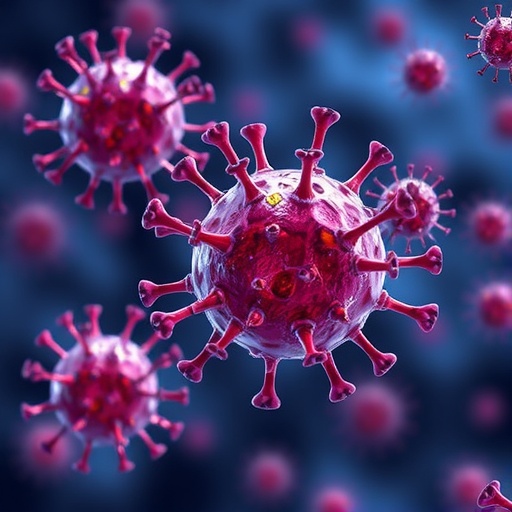In a groundbreaking advance that promises to reshape our approach to influenza virus control, researchers have unveiled a new class of human monoclonal antibodies that exhibit extraordinary cross-neutralizing capabilities against both historical and emerging H5Nx influenza viruses. These findings are poised to catalyze a significant shift in the therapeutic and preventive landscape for influenza, particularly in curbing avian-origin strains that pose pandemic threats.
The influenza virus remains a formidable global health challenge, notorious for its rapid evolution and capacity to jump species barriers. Among its various subtypes, H5Nx viruses—where “Nx” represents various neuraminidase variants—have been recurrently implicated in outbreaks and sporadic human infections. These variants, evolving unpredictably in avian populations, have long vexed researchers and public health officials due to their antigenic diversity and zoonotic potential.
This new study, published in the prestigious journal Nature Microbiology, dives deeply into the structural and functional nuances of a collection of human monoclonal antibodies derived from individuals previously exposed to diverse H5Nx strains. By leveraging advanced immunological techniques, single-cell cloning, and high-resolution cryo-electron microscopy, the researchers have illustrated how these antibodies recognize conserved epitopes on the viral hemagglutinin (HA) protein.
Central to this discovery is the identification of broadly neutralizing antibodies (bnAbs) that target highly conserved regions of hemagglutinin, circumventing the virus’s notorious antigenic drift. These antibodies exhibit an impressive capacity to neutralize a broad spectrum of H5Nx strains isolated over the past decades alongside current and emerging variants. This broad reactivity hints at the presence of key “Achilles’ heel” sites within the HA structure, which may serve as universal vaccine targets.
The functional assays conducted indicate that these monoclonal antibodies not only bind with high affinity but also effectively inhibit viral fusion and entry processes, critical steps for successful infection. Moreover, in vivo studies in suitable animal models demonstrated marked protection against lethal viral challenges, underscoring the therapeutic potential of these antibodies in both prophylactic and treatment contexts.
The implications of these findings extend beyond therapeutic applications. By mapping the conserved epitopes that underpin cross-neutralization, vaccine designers can now more strategically engineer immunogens to elicit similar broadly protective immune responses. This prospect is particularly impactful for pandemically poised H5Nx viruses, where rapid viral evolution often undermines the efficacy of traditional strain-specific vaccines.
Advancing this antibody discovery into clinical settings, however, remains a complex but achievable challenge. Large-scale production, optimization of antibody pharmacokinetics, and comprehensive safety assessments are required before human deployment. Nonetheless, the study lays a robust vision for harnessing human-derived monoclonal antibodies as a frontline defense against emergent influenza strains.
The study also exemplifies the power of integrating multidisciplinary approaches—combining virology, structural biology, and immunology—to illuminate viral vulnerabilities that have eluded earlier efforts. The use of single B-cell screening and deep sequencing allowed for an unprecedented granular view of the human antibody repertoire reacting to H5Nx exposure.
Moreover, this research highlights the critical importance of sustained surveillance of avian influenza viruses circulating in wild and domesticated bird reservoirs. Such surveillance ensures timely identification of antigenic shifts and provides the necessary biological material to isolate potent monoclonal antibodies with cross-protective features.
From a public health perspective, these findings potentially herald a new paradigm where, in the face of future influenza outbreaks, stockpiles of broadly neutralizing antibodies can be mobilized rapidly to confer immediate passive immunity. This approach could bridge the temporal gap before vaccine formulations can be updated and broadly distributed.
The demonstration of cross-neutralization against both historical and emergent H5Nx strains also suggests a remarkable evolutionary conservation of viral epitopes, which could be exploited more broadly across influenza subtypes. This raises tantalizing prospects for universal influenza vaccines and antibody therapies that transcend seasonal and subtype boundaries.
In summary, the revelation of these potent human monoclonal antibodies targeting the hemagglutinin of H5Nx viruses is a beacon of hope amid the ongoing challenge of influenza virus control. It revives optimism for durable, broad-spectrum immunological interventions capable of preempting future influenza pandemics from avian and potentially other zoonotic sources.
As the scientific community continues to dissect the molecular underpinnings of these antibodies’ breadth and potency, attention now turns to clinical translation and integration with existing influenza management strategies. The path forward, while demanding, is illuminated by the promise of these findings to redefine influenza prophylaxis and therapy.
The integration of such monoclonal antibodies into routine influenza preparedness portfolios could be complemented by advances in rapid antibody discovery platforms and novel delivery mechanisms, enhancing the agility of our response to viral threats.
Ultimately, this research not only enriches our understanding of human immune responses against complex influenza viruses but also invigorates the pursuit of next-generation countermeasures that could decisively tilt the balance against influenza’s global burden.
Subject of Research: Cross-neutralizing and potent human monoclonal antibodies targeting historical and emerging H5Nx influenza viruses.
Article Title: Cross-neutralizing and potent human monoclonal antibodies against historical and emerging H5Nx influenza viruses.
Article References:
Abu-Shmais, A.A., Freeman, G., Creanga, A. et al. Cross-neutralizing and potent human monoclonal antibodies against historical and emerging H5Nx influenza viruses. Nat Microbiol (2025). https://doi.org/10.1038/s41564-025-02137-x
Image Credits: AI Generated
Tags: antibody discovery techniquesavian-origin flu strainsbroadly neutralizing antibodiescross-neutralizing capabilitiesH5Nx influenza viruseshuman monoclonal antibodiesinfluenza virus evolutionNature Microbiology publicationpandemic influenza preventionstructural immunologyviral hemagglutinin targetingzoonotic viruses





